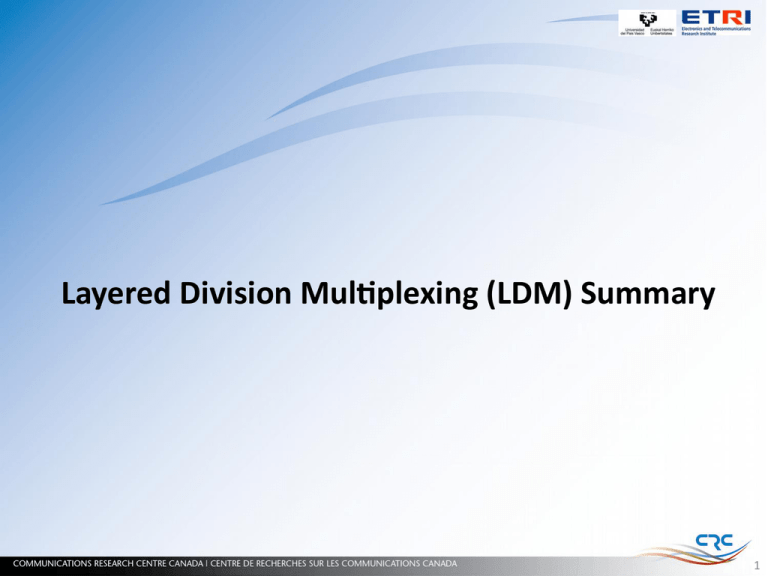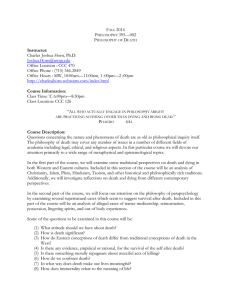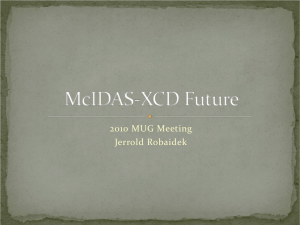Layered Division Multiplexing (LDM) Summary
advertisement

Layered Division Multiplexing (LDM) Summary 1 2 Layered Division Multiplexing • LDM super-imposes multiple physical layer data streams with different power levels, channel coding and modulation schemes for different services and reception environments; • It enables more flexible use of spectrum to deliver mobile HDTV and UHDTV simultaneously in one 6 MHz channel to mobile, indoor, and fixed reception terminals; • 100% of RF bandwidth and 100% of the time are used to transmit the multi-layered signals for better time and frequency diversity, and robust reception; • A receiver will decode the upper layer most robust signal first, cancel it from the received signal, and start decoding the second layer signal; • LDM can have 3-6 SNR gain comparing with Traditional TDM system. 5 dB 5 dB Stream A Stream B RF Channel BW Stream C LDM system: hierarchical spectrum re-use to improve reception performance. 3 LDM Tx Functional Architecture downlink Control Info Formatting BICM Freq Int’l Preamble Output Output (SISO) (MIXO / TFS) Data 1 D/A Data 2 Framer Scheduler Scrambler FEC1 Bit-Int’l1 Mapper1 FEC2 • • • Bit-Int’l2 Mapper2 Time-Int’l MIXO OFDM Freq Int’l Framer / Injection cell Level mux / TFS MISO / STR Pilot / Tone Reserve SFN IFFT PAPR GI Preamble/ Spectrum Shaping Additional blocks Required for LDM LDM is independent to MIMO, MISO, PLP, TI, Pilots, GI, pre-amble and PAR; LDM receiver complexity increase is less than 10%; LDM SNR performance gain is 4-6 dB for AWGN, and even higher SNR gains for mobile and strong multipath channels, due to stronger FEC and modulation used. 4 Cloud Txn Receiver (two layers) Diagram: Cell to LLR, LLR de-int’l, LDPC decoder less than 10 iteration Sync & Timing Time De-Int’l Clock Recovery Stream A Decoder Delay Tuner IF & Down Converter OFDM Demod & Equalization A-D Converter AGC + Data buffer: 32k +α cells Bit to Cell Mapping Data + FEC Bit to cell mapping Bit Int’l 64kbits Stream B Decoder Common for TDM and LDM Stream A Stream B Cell to LLR, LLR de-int’l LDPC code less than 50 iteration • A multi-layer system does not increase the receiver complexity by much; • A large part of the circuits can be shared (tuner, sync, IF, ADC, AGC, equalizer, etc.); • Upper layer needs FEC decoding, bit to symbol mapping, signal cancellation and DELAY data buffer; • About 8% LDPC computation complexity increase and less than 10% memory increase for a 2-layer system receiver. 5 LDM System (6 MHz RF Channel) Upper layer signal spectrum QPSK FEC R = ¼ 2.5 Mbps Mobile HDTV S/N = - 3 dB Lower layer signal spectrum 256QAM FEC R = 8/15 24 Mbps UHDTV-4k S/N = 14 dB Two signals are super-imposed (symbol by symbol mix) at a selected injection level Injection level 5 dB 6 MHz RF Channel BW S/(N+I) = - 3 dB S/N = -1 dB S/I = 5 dB “I” is lower layer interference S/I = - 5 dB “I” is upper layer interference Hierarchical spectrum re-use to improve spectrum efficiency and flexibility Signal cancellation Residual/noise Direct decoding of upper layer signal 5 dB Lower layer interference Lower layer signal after Upper layer signal cancellation C/I residual > 30 dB S/(N+I residual) ≈ S/N = 14 + 5 dB = 19 dB Ref. to the total Tx power 6 More Flexible Use of Broadcasting spectrum • • • • In point-to-point communications, e.g., LTE, adaptive modulation and coding, as well as Tx power adaptation are used to fully explore the channel capacity; Broadcasting system is an one-to-many communication, the system is really designed to provide satisfactory service to the audiences at the End-of-Coverage; For audiences well inside the broadcast coverage area, they have very high field strength. This is not efficient use of channel capacity and those audiences can have better services; Solution: combine various services in one RF channel for tiered services. Field strength Field strength Traditional Broadcasting One tier service Multi-layer services: Tier 1, 2 and 3 Tier 3 Coverage End of Coverage Distance Tier 2 Coverage Tier 1 Coverage Distance Tiered coverage is not new, ACATS proposals, DVB-T/T2, ISDB-T, ATSC M/H all can do it. LDM can make it working better, with more robust mobile/handheld HDTV solution. 7 LDM 2-Layer System Coverage (outdoor) with one robust mobile upper layer (S/N = 1.5 dB, 4 Mbps, 1080p/60 or 2 x 720p/60) and one high-data rate lower layer (S/N = +19 dB, 20 Mbps, 4k-UHD or multi-HDTV) Upper layer fix reception: 10m directional antenna, F(50,90), S/N = 1.5 dB, 4 Mbps, 1080p/60 Stationary HDTV, robust audio Upper layer portable reception: 1.5m Omni-directional antenna, S/N = 1.5 dB, 4 Mbps, 1080p Portable/handheld HDTV (tablets), Robust audio, F(50,90) Upper layer mobile reception: 1.5m Omni-directional antenna, S/N = 4.5 dB, 4 Mbps, 1080p HDTV Vehicle speed (150+ km/h), Robust audio, F(90,90) Lower layer fix reception: 10m directional antenna, S/N = 19 dB, 20 Mbps, 4k-UHD or multiple HDTV 1080p, Immersive audio, F(50,90) 8 LDM Co-existence with other Technologies: • A 2-layer LDM system, by nature, has one robust mobile/indoor PLP and one high data rate PLP for UHD or multiple HD services; • LDM with layered transmission is naturally fit for Scalable Video Coding (SVC); • Audio can be carried by robust mobile layer for extrarobustness; • LDM can work with the traditional TDM/FDM to form 2-D or 3-D multiplexing; • Backward compatible “Future Extension Layer (FEL)” can be added later, without impact the legacy services data rate. 9 LDM Flexibility: • LDM is an enhanced TDM, which allows multi-layer transmission; • A LDM system can do TDM, LDM, as well as mixed TDM/LDM; • The injection level between layers is an important parameter to distribute the total transmitter power between layers; • For example: A 6 dB injection level difference means 80% of the Tx power are assigned to mobile/indoor service, and 20% for fixed service; • It gives broadcasters more flexibility! 10 Transition scenario and Future Extension Layer: • During the transition period, an one-layer system can be deployed first to provide two 720p/60 HD mobile and indoor service at about 4 Mbps and SNR = -0.5 dB (AWGN); • A lower layer can be added for 4k UHD or multiple HD fixed services, data rate ranges from 15 to 30 Mbps for high frame rate UHD at SNR = 14 to 24 dB; • The two 720p/60 upper layer can be changed to one 1080p/60, if desired; • Adding additional layers later without impact legacy services is one of the benefit on LDM: The legacy receiver will not go dark; the new service can be introduced seamlessly; CE can sell another round of new Rxs; • The network is scalable and it can grow. 11 LDM vs. TDM System LDM (two layers) vs. DVB-T2+NGH (single layer, baseline code, no pre-amble) 6 MHz RF Channel (-4 dB Lower Layer Injection) LDM System Mobile 55% Capacity Mobile 40% Capacity Mobile 30% Capacity Data rate SNR Data rate SNR Data rate SNR Data rate SNR 2.0 Mbps QPSK 3/15 -2.0 dB 2.0 Mbps QPSK 6/15 -0.4 dB 2.0 Mbps QPSK 8/15 1.3 dB 2.1 Mbps QPSK11/15 3.7 dB Upper layer 2.7 Mbps QPSK 4/15 -0.3 dB 2.7 Mbps QPSK 8/15 1.3 dB 2.7 Mbps QPSK 11/15 3.7 dB 2.6 Mbps 16Q 7/15 5.3 dB Upper layer 4.1 Mbps QPSK 6/15 2.7 dB 4.1 Mbps 16Q 6/15 4.3 dB 4.0 Mbps 16Q 8/15 6.4 dB 4.1 Mbps 16Q 11/15 9.6 dB Upper layer Hardware (robustmod) (mid-rate) (high-rate) Low layer with -4 dB injection Fixed(TDM) 45% Fixed(TDM) 60% Fixed(TDM) 70% Hardware Low-rate 14.3 Mbps 64Q 7/15 14.6 dB 14.4 Mbps 256Q 11/15 18.9 dB 14.4 Mbps 64Q 11/15 14.4 dB 15.3 Mbps 64Q 10/15 13.0 dB Mid-rate1 20.5 Mbps 64Q 10/15 18.5 dB 19.6 Mbps 1kQ 12/15 25.6 dB 21.0 Mbps 256Q 12/15 20.7 dB 20.4 Mbps 256Q 10/15 17.3 dB Mid-rate2 24.6 Mbps 256Q 9/15 21.2 dB - N/A 24.0 Mbps 1kQ 11/15 23.5 dB 24.4 Mbps 256Q 12/15 20.7 dB High-rate 30.1 Mbps 256Q 11/15 24.4 dB - N/A - N/A 30.6 Mbps 1kQ 12/15 25.6 dB All SNR power levels are referenced to the total RF in-band power (of all layers) LDM: 16K FFT, GI= 1/16, P12,2. TDM: Fixed 32K FFT, GI = 1/32, P24,4; Mobile 8K FFT, GI = 1/8, P6,2. 12 4k-UHD (19.43Mbps, 60 frames) HD (2.57Mbps, 60 fps, 720p) Tx and Antenna (ch.50) Rx and Antenna Constellation Controller (Tx PC) Spectrum LDM Prototype Hardware & Demo configuration Mobile/Indoor: 2.6 Mbps 720p SNR = -0.4dB. High data rate: 20Mbps 4kUHD SNR = 18.5 dB. 13 LDM Constellation Lower layer non-uniform 64QAM LDM Constellation on the Prototype Hardware 14 ETRI Hardware Parameters Hardware Parameters @ 6MHz FFT FFT Size Size CP CP Size Size OFDM OFDM Waveform Waveform Modulation and Modulation Coding and Coding 16K 16K (16384) (16384) 1024 1024 (6.25%) (6.25%) # of guard subcarriers # of guard subcarriers # of used subcarriers # of used subcarriers # of pilot subcarriers # of pilot subcarriers # of data subcarriers # of data subcarriers OFDM sample length OFDMCP sample lengthlength 2751 (16.79%) 2751 (16.79%) 13633 (83.21%) 13633 (83.21%) 1197 (7.31%, PP2(12,2)) 1197 (7.31%, PP2(12,2)) Scattered/continual/edge pilots (from T2) Scattered/continual/edge pilots (from T2) 12436 (75.9%) 12436 (75.9%) 7/48us (~0.1458 us) 7/48us (~0.1458 0.1493 ms us) CP length Useful OFDM symbol length 0.1493 2.3893 ms ms Useful symbol OFDMOFDM symbol lengthlength (Ts) 2.3893 ms 2.5387 OFDM symbol length(Δf) (Ts) Subcarrier spacing 418.527 Hz 2.5387 ms Occupied BW (Δf) Subcarrier spacing Preamble Occupied BW 5.7058 418.527MHz Hz Hierarchical (2%) (from ETRI proposal) 5.7058 MHz UL BICM Preamble LL BICM UL BICM Injection level LL BICM Time Interleaver Injection level 4/15 LDPC (64k) & QPSK (from baseline) Hierarchical (2%) (from ETRI proposal) 10/15 LDPC (64k) & 64NUC (from baseline) 4/15 LDPC (64k) & QPSK (from baseline) -4 dB (variable from -3 ~ -10 dB) 10/15 LDPC (64k) & 64NUC (from baseline) Time Interleaver Frame size Block type (from T2) 250 ms Frame size 97 OFDM symbols 246.25 ms -4 dB (variable from -3 ~ -10 dB) 15 Laboratory Test Results • Required C/N after LDPC decoding • AWGN, DVB-F1/P1, 0dB echo performance - BER = 1 x 10-6 - Step size = 0.1 dB • TU-6 performance (UL) @ PER = 0.1% Gaussian Channel (AWGN) Ricean Channel (DVB F1) Rayleigh Channel (DVB P1) 0dB Echo Channel @ 73us TU-6 @60km & 120km/h UL -0.5 dB -0.3 dB 1.3 dB 1.7 dB 3.0, 3.5 dB LL 18.2 dB 18.6 dB 20.9 dB 21.8 dB - UL -0.3 dB -0.1 dB 1.5 dB 1.8 dB 4.1, 4.6 dB LL 18.5 dB 18.9 dB 21.6 dB 22.2 dB - Injection Level = -4 dB Simulation HW test Both Hardware and Simulation are using DFT-base channel estimation. Simulation assumes perfect synchronization. HW performance can be further improved. 16 16 LDM vs. ATSC Mobile (mix & 1/4 rates) LDM Mobile service ATSC Mobile LDM vs ATSC Mobile Mixed Rate Quarter Rate 2.7 Mbps 2.2 Mbps 1.4 Mbps 23% better 93% better Coding mode QPSK, 1/4 code Mixed Rate 1/4 Rate - - SNR@AWGN -1 dB 7 dB 3.5 dB 8 dB better 4.5 dB better SNR@TU-6 +3 dB 17 dB 13 dB 14 dB better 10 dB better (mobile) Fixed service 14 Mbps Two 1080p HEVC 11 Mbps One 1080i MPEG-2 Mod & coding 64QAM + 7/15 LDPC 8-VSB, Trellis + R-S - Injection level 5 dB below mobile TDM with mobile - SNR @AWGN 15 dB 15 dB Same SNR @0 dB echo 19 dB 22+ dB 3+ dB improvement (SFN) 3 Mbps higher data rate or 27% better 17 Conclusions and Suggestions: • LDM can achieve significant performance gains (3 to 6 dB) and can have backward compatible future extension; • LDM can co-exist with all other proposed new technologies; • LDM has been tested, cross-checked, hardware built; • LDM should be accepted as the baseline technology for the ATSC 3.0 PHY standard, expeditiously, so that there is sufficient time to build ATSC 3.0 compliant hardware for laboratory and field tests and to maintain the standardization time table. 18 Thank You 19 Channel Capacity: LDM vs. Single Layer TDM AWGN Channel Capacity, Mobile channel, Injection Level = 5dB 1.8 Cloud-CLayer TDM/FDM Mobile, 25% TDM/FDM Mobile, 33% TDM/FDM Mobile, 50% 1.6 6 1.2 1 0.8 0.6 5 4 3 0.4 2 0.2 1 0 -10 -8 -6 -4 -2 0 SNR [dB] Cloud-CLayer TDM/FDM Fixed, 75% TDM/FDM Fixed, 67% TDM/FDM Fixed, 50% 7 Capacity, [bit/Hz/s] Capacity, [bit/Hz/s] 1.4 AWGN Channel Capacity, Fixed channel, Injection Level = 5dB 8 2 4 6 8 LDM upper layer capacity vs. TDM single layer system with 50%, 33.3% and 25% capacity for mobile services: At 0.4 b/s/Hz, the LDM upper layer is 1.8, 4.3 and 6.3 dB better, respectively. At 0.8 b/s/Hz, the LDM upper layer is 1.8, 5.2 and 8.1 dB better, respectively. 10 0 5 10 15 20 25 30 SNR [dB] LDM lower layer capacity vs. TDM single layer system with 50%, 66.7% and 75% fixed services: The LDM lower layer curve (dark blue) crossed 50% curve at 8 dB, 66.7% curve at 18 dB, and 75% curve at 24 dB. It has advantage at high data rate! 20 20


